FRENCH RESISTANCE, WEHRMACHT CLASH
Mont Mouchet, South-Central France • June 20, 1944
During the Allied invasion of France (Operation Overlord), the Maquis and other French resistance groups played a vital role in delaying the arrival of German reinforcements to the Normandy beachhead as well as in the eventual Allied victory in France. The FFI, or Fifis (Forces Françaises de l’Interieur for “French Forces of the Interior”), and Francs-Tireurs (roughly “French Gunmen”) sabotaged railroad tracks and repeatedly attacked German Army equipment and garrison trains on their way to Normandy, helping to isolate the invasion site from the rest of occupied France. Thanks to coded “personal messages” broadcast on the eve of D‑Day by the BBC during its segment “French speaking to French” (les français parlent aux français), the maquisards (as Maquis members were known) were alerted to the impending invasion and their assigned roles in it by listening for these pre-arranged messages, meaningless to most eavesdropping Germans, read in a continuous flow over the airwaves. At last, at 9:15 p.m. on June 5, 1944, a BBC French-speaking announcer began reading, over and over again, the vital messages, among them: “The dice are on the table . . . The tomatoes are ripe and ready for plucking at Perpignan. . . .” and the second and triggering part of a French poem by Paul Verlaine.
As Allied troops advanced from their beachheads in June 1944, the FFI, whose ranks approached 200,000 (at its peak there would be 300,000), rose against the Nazi occupation forces and their garrisons en masse. On this date, June 20, 1944, in South-Central (formerly Vichy) France, a group of 7,000 maquisards led by British Special Operations Executive (SOE) agent Nancy Wake, who was married to a Frenchman, began a series of pitched battles against upwards of 22,000 German SS soldiers. Between April 1944, when Wake parachuted into France, and August, her group accounted for 1,400 German casualties, while losing only 100 themselves.
On the Vercors plateau west of the French Alps, a Maquis group led resistants in establishing a short-lived Free Republic of Vercors in June and July 1944, which ended in defeat and civilian atrocities. When engaging the enemy, some Maquis groups took no prisoners, so enemy soldiers often preferred to surrender to Allied soldiers instead of facing the maquisards. Maquisards, whether captured by the Germans or by Vichy France’s Milice (French militia), faced torture, death, or concentration camps, where few survived (see photo essay below).
When Gen. Charles de Gaulle set up a Free French administration after the liberation of Paris in August 1944, many maquisards returned to their homes but many also joined the new French army to continue fighting the Germans. France was rewarded for its tenacity against Adolf Hitler’s tyranny by joining the U.S., Britain, and the Soviet Union in stationing troops and administrating zones of occupation in a defeated Germany. The French zone lay to the east of the Rhine River, the decades-long contested boundary between France and Germany.
![]()
French Resistance Forces Target Both Germans and Collaborators
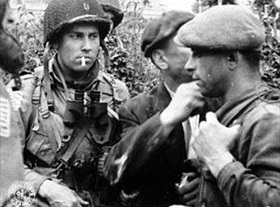 | 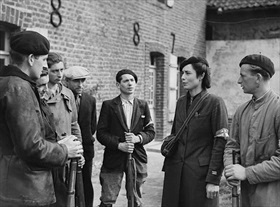 |
Left: The French Resistance was never a homogeneous organization. Its factions often acted like warring tribes, riven by political allegiances and personality clashes and sometimes putting bounties on each other’s heads. Until 1944 nonviolent members and rural and urban guerrillas of the French underground were lumped under the collective term une armée secrète. By the spring of 1944 membership in the various underground groups may have approached 350,000 (out of a total French population of 35 million), of which 100,000 may have had serviceable weapons. At most a half-million people, or less than 2 percent of the population, were involved one way or another in the Resistance. Four-fifths of the resistants were less than 30 years old. They were an impudent annoyance that grew in intensity, but they posed no serious threat to Germany’s occupation of France or to Vichy French authorities, which acted as a second occupation force. Their main contributions lay in gathering intelligence and conducting sabotage operations; e.g., against rail, electricity, and phone lines, locomotives, bridges, and tunnels, the latter more difficult to repair. This photo depicts Allied paratroopers and beret-wearing French resistance fighters with Francs-tireurs et partisans, which operated under communist control, sharing information during the Battle of Normandy, June 6 to mid-July 1944. According to Allied Supreme Commander Gen. Dwight D. Eisenhower the resistants shortened the French campaign by 2 months.
![]()
Right: Members of the Maquis in the hamlet La Trésorerie near Boulogne-sur-Mer along the Pas-de-Calais coast in the Hauts-de-France region, September 14, 1944. Although it is not her in this photo, the female figure bears an uncanny resemblance to the British SOE agent Nancy Wake (1912–2011). The Gestapo nicknamed Wake the “White Mouse” due to her ability to evade arrest and escape when she was in custody. The Gestapo offered a 5-million-franc reward for her capture. In one raid on a Gestapo headquarters no less, Wake delivered a single karate chop that killed a German sentry to prevent him from raising an alarm.
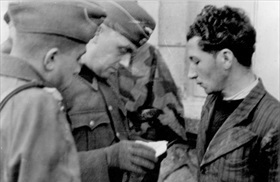 | 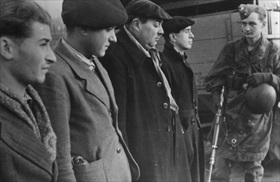 |
Left: Associated with this photo, the German text written by a German Armed Forces correspondent named Koll in July 1944 reads: “A good catch by German soldiers in France. The Communist leader is on the list of the wanted. His escape was thwarted by ‘Streif’ commandos. His papers prove his affiliation to terrorist groups.” A member of the Propagandakompanie der Wehrmacht, Koll titled his piece, “The ‘Red’ Resistance in France.” Communists were a significant segment in the French Resistance. Having supported the Nazi invasion of their country owing to the German-Soviet Nonaggression Pact of August 1939, French communists switched their allegiance after Hitler’s June 1941 invasion of the Soviet Union (Operation Barbarossa).
![]()
Right: Koll’s text associated with this photo from July 1944 reads: “Arrested terrorists before deportation. The leaders of the gangs are Jews, who fled communist Spain [i.e., Republican Spain], and English [SOE] agents, who are usually well dressed and equipped with large sums of money. Their henchmen are recruited almost exclusively from work-shy rabble.” As good as they were in ferreting out members of the Resistance, the German and Vichy French intelligence services relied heavily on ordinary French men and women to betray their fellow citizens to the authorities.
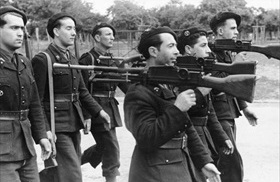 | 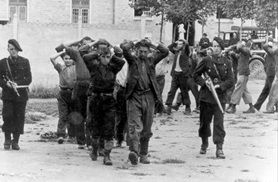 |
Left: Germany’s brutal occupation of Europe precipitated the rise of all sorts of home-grown resistance movements that targeted members of the Wehrmacht (German armed forces) as well as supporters of collaborationist regimes like Marshal Pétain’s Vichy France—creating forms of civil war inside each occupied country. The Milice française, or simply Milice, was a predatory Vichy paramilitary force formed in early 1943 with help from the Germans to fight the growing presence and armed capabilities of the French Resistance. A good percentage of the Milice were the dregs of French society—petty criminals, fanatical anti-terrorists, and ex-prisoners brandishing their newly acquired weapons. Incredibly, 1 in 6 miliciens was female. Resistance fighters targeted the thuggish miliciens for assassination, believing them more dangerous to their cause than the hated German Gestapo and SS. “Kill the miliciens,” a widely circulated clandestine flyer read, “exterminate them like rabid dogs.” German correspondent Koll’s text for this photo reads: “Members of the French Milice parade with shouldered armor-clad machine guns.”
![]()
Right: Koll’s text reads: “Numerous prisoners taken in an operation against the terrorists in France. Among them are many criminal elements who are guilty of murder, robberies, railroad bombings, etc. They are guarded by the Milice française, who stand shoulder-to-shoulder with German soldiers against Bolshevism.” Roughly 100,000 men and women whom the Germans and Vichyists labeled “terrorists” may have been killed in battle or, after capture, in prison following death sentences handed down by miliciens acting as judges, against which there was no appeal.
1944 Newsreel Account of the Liberation of France
![]()

 History buffs, there is good news! The Daily Chronicles of World War II is now available as an ebook for $4.99 on Amazon.com. Containing a year’s worth of dated entries from this website, the ebook brings the story of this tumultuous era to life in a compelling, authoritative, and succinct manner. Featuring inventive navigation aids, the ebook enables readers to instantly move forward or backward by month and date to different dated entries. Simple and elegant! Click
History buffs, there is good news! The Daily Chronicles of World War II is now available as an ebook for $4.99 on Amazon.com. Containing a year’s worth of dated entries from this website, the ebook brings the story of this tumultuous era to life in a compelling, authoritative, and succinct manner. Featuring inventive navigation aids, the ebook enables readers to instantly move forward or backward by month and date to different dated entries. Simple and elegant! Click 











